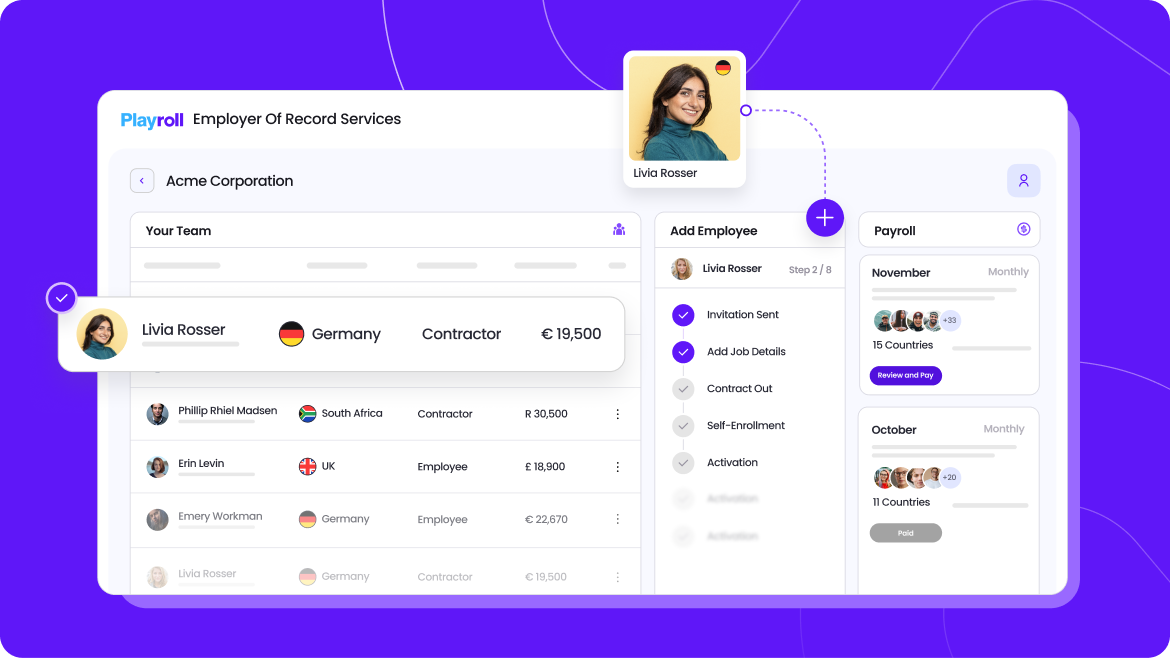Copied to Clipboard
Ready to get Started?


Key Takeaways
Global Mobility is More than Relocation: It integrates immigration, payroll, tax, compliance, and employee experience into a single framework that supports both business and talent growth.
Costs Can be Planned and Managed: Relocation, visas, tax advisory, and cost-of-living allowances are predictable with the right policies, checklists, and providers.
Compliance is Non-Negotiable: Companies must navigate employment laws, payroll rules, tax systems, and data privacy standards in every country they operate.
Growth doesn’t happen in silos anymore. Your customers, investors, and future hires are spread across the world, and if you want to stay competitive, you need to meet them there. But while expanding internationally is easier to imagine than ever, it’s often harder to execute than most leaders expect.
Each country comes with its own set of rules: contracts that look nothing like the ones you use at home, benefits packages defined by local law, payroll that must run in the local currency, and immigration approvals that move at their own pace. Layer on cultural differences and the logistical realities of relocating people, and expansion can quickly stall before it even starts.
This is where global mobility matters. For employers ready to scale, the challenge goes over and above putting boots on the ground. To be successful, you need to build systems that allow talent to move seamlessly, contribute immediately, and stay fully compliant in every host country. In this guide, we’ll talk you through how having these systems in place can make international growth a repeatable, scalable advantage, instead of a gamble.
What is Global Mobility?
At its simplest, global mobility, or employee mobility, is the ability to move people across borders so your business can grow where the opportunity is. It encompasses everything from short-term assignments and business travel to long-term expatriate placements and permanent relocations.
In practice, it’s much more than booking flights or arranging housing. A well-designed global mobility program brings together immigration, tax, payroll, compliance, and cultural support so that employees can hit the ground running and businesses can expand without running afoul of local regulations.
For employers, that can look like:
- Hiring top talent in a new market without the delay and cost of setting up a local entity.
- Relocating a senior leader knowing that tax, payroll, and immigration are fully compliant.
- Managing payroll and benefits across multiple countries from one central platform.
1. Business Travel: A Few Days
Business trips are the most common and straightforward form of mobility. Employees travel abroad temporarily to attend meetings, conferences, training sessions, or to manage short-term projects. For example, a manager from London travels to Singapore for two weeks to conduct client meetings and deliver a workshop.
Key features:
- No change in employment location (they remain employed in the home country).
- Limited impact on payroll or tax residency.
- Typically, visa-exempt or covered by short-term business visas.
2. Short-Term Assignments: 3 to 12 months
Short-term assignments address specific business needs like project launches, process transitions, or specialized training. For example, a software engineer from Berlin is sent to Toronto for six months to support a product implementation.
Key features:
- The employee temporarily works in another country but remains on the home-country payroll.
- The company handles visas, temporary housing, and possibly per diem allowances.
- Tax obligations may arise in both countries, requiring careful coordination.
3. Long-Term Expatriate Assignments: 1 to 5 years
Long-term assignments help companies transfer expertise, build global leadership, or establish new operations. For example, a finance director from New York relocates to Dubai for three years to oversee the company’s Middle East operations.
Key features:
- The employee typically moves with family.
- A formal expatriate package covers housing, education, relocation, tax equalization, and cost-of-living adjustments.
- The employee remains tied to the home employer but may work under a host-country contract.
- Dual taxation and compliance become more complex, often requiring professional management.
What Are the Business Benefits of Building a Global Mobility Policy?
If you get it right, global mobility can act as both a compliance safeguard and effective growth driver. The best programs align business goals with employee experience, turning each international assignment into an opportunity to build skills, boost retention, and speed up your market entry without compromising on compliance.
Some of the key benefits of a strong global mobility policy include:
- Access to Global Talent: Recruit the best people wherever they live.
- Market Expansion: Place skilled employees in-region to build credibility and local expertise.
- Employee Development: Grow leadership, cultural fluency, and adaptability through international assignments.
- Talent Retention: Keep high performers engaged by offering global career opportunities.
- Knowledge Transfer: Move ideas and best practices quickly across teams and geographies.
- Agility: Redeploy teams as priorities shift, with the right systems in place to support them.
- Diversity and Inclusion: Create a workforce that reflects multiple perspectives and sparks innovation.
- Compliance Management: Stay ahead of employment laws, tax regulations, and immigration rules in every host country.
Important Considerings for Developing a Global Mobility Program
A strong global mobility program will act as a framework that balances compliance with employee experience, giving your business the ability to scale internationally without unnecessary risk.
Here are the key elements that form part of a modern program:
Immigration and Work Authorization
Every project begins with permission to work. From visas to residence permits, businesses need reliable systems to manage immigration timelines, eligibility checks, and renewals. For example, securing a work permit or visa sponsorship for an employee relocating from their home country to a host country like Germany may involve months of preparation and documentation.
Global Payroll and Tax Compliance
Payroll doesn’t stop at borders. Employees must be paid accurately, in their local currency, while contributions to tax and social security are handled correctly. Many companies integrate global payroll solutions into their mobility program to avoid compliance risks and ensure international employees are supported from day one.
Compensation and Benefits Design
Relocating employees often requires different layers of adjustments to maintain fairness and competitiveness. It’s a good idea to outline what these benefit or compensation changes might look like in your global mobility policy because it’ll help you manage costing and employee expectations. Adjustment could come in the form of housing allowances, relocation bonuses, or cost-of-living adjustments to reflect the realities of the host country.
Relocation and Family Support
Moving abroad affects more than just you and your team members, it’ll impact their entire family as well. It’s a good idea to include relocation services such as temporary housing, school search support, and settling-in assistance in your global mobility plan. They can determine whether an assignment succeeds or fails.
Cultural and Professional Development
Global mobility is also about growth for both your company and your employees. Offering global mobility training – from language classes to cross-cultural coaching – helps employees adapt quickly and build skills that make them stronger leaders.
Ongoing Compliance Oversight
Even after relocation, compliance doesn’t end. Labor laws, reporting requirements, and tax obligations change frequently. Many businesses partner with an EOR to manage these complexities, ensuring that every international assignment is compliant by default.
How to Create a Global Mobility Program for Growing Your Business
Building a global mobility program doesn’t need to be overwhelming. The most effective programs follow a clear structure that connects business priorities with employee needs.
Here are five steps to get started:
1. Define Your Objectives
Start with mapping out the “why” of your global expansion plan. Are you relocating employees to launch in a new market, to close a specific skills gap, or are you trying to develop future leaders? Setting clear goals will set up the runway for a global mobility strategy that supports growth instead of one that becomes an administrative burden.
2. Map Compliance Requirements Early
From visas to payroll, compliance needs to be addressed from the very beginning. Each host country has its own requirements and failing to prepare for them can delay an assignment by months.
Keeping a global compliance checklist on hand will help your HR and leadership teams track obligations across immigration, tax, payroll, and labor laws.
3. Create Your Global Expansion Policy
Once you’ve defined your expansion goals and mapped out strategies for overcoming any compliance hurdles you’re likely to encounter, you’re ready to create your policy.
A well-designed policy will include:
- Purpose and Objectives: Why the company is expanding globally and what success looks like.
- Market Entry Strategy: Approved models (e.g. EOR, subsidiaries, joint ventures) and decision criteria.
- Compliance Framework: Employment laws, payroll, tax, immigration, and data privacy standards.
- Global Mobility Policy: Rules around relocating employees, including allowances, benefits, and re-entry.
- Compensation and Benefits: Guidelines for pay parity, cost-of-living adjustments, and local benefits compliance.
- Talent and Hiring: Whether to hire local employees, relocate staff, or use contractors, and how to stay compliant.
- Cultural Integration: Support for training, onboarding, and inclusive practices in new markets.
- Governance and Accountability: Who owns decision-making, approvals, and compliance monitoring.
- Risk Management: How the company mitigates legal, financial, and reputational risks.
- Review and Evaluation: How success is measured and how policies adapt over time.
4. Invest in Employee Support and Training
Relocation can be stressful. Providing cultural orientation, language support, and ongoing career development helps employees adapt quickly and stay productive. For instance, companies moving staff to Japan often provide Japanese language lessons and cultural coaching to ease the transition and strengthen collaboration with local teams.
5. Measure and Refine Your Program
Global mobility should evolve with your business. Track outcomes such as retention rates, assignment success, and the cost versus return of relocations. Reviewing your global mobility programme regularly ensures it scales as your company expands, while keeping employee experience front and center.
Global Mobility Services for Expanding Businesses
As your company scales, you will encounter more complexities – with unique labor laws, tax rules, and compliance requirements to juggle per region. Managing it all in-house can quickly become too costly and time-consuming. In many cases, it’s more efficient and cost-effective to outsource scaling mechanisms to a global mobility service provider, giving your business access to the expertise and infrastructure it needs to expand.
The right provider should simplify expansion, protect your business from risk, and support your people so they can focus on doing their best work. Here are the core elements a strong provider should offer:
Employer of Record services
At the core of most global mobility services is the EOR model. An EOR acts as the legal employer for your international team through its network of local entities – handling contracts, payroll, and compliance while taking on the legal liability for each hire.
This approach saves companies from the cost and delays of setting up their own subsidiaries and protects against penalties tied to non-compliance with local labor and tax laws. In short, it’s the fastest and safest way to hire globally without building entities country by country.

Visa support services
Immigration can be a major barrier to moving talent. A strong mobility partner provides end-to-end visa support, from eligibility checks to application management and documentation. This reduces delays, ensures compliance, and frees your HR team from the administrative workload.
Global payroll solutions
Paying employees across multiple countries is another complex layer of the global expansion onion. A good global payroll provider can simplify paying your team (full-time employees and contractors) on time and in their preferred currencies.
The best providers also:
- Forecast the full cost of international hires using accurate data and tooling
- Manage contractor invoices and payments
- Handle benefits in line with local requirements, keeping your company competitive
- Provide insights into local pay expectations and benchmarks using real-time, accurate data analytics
In-country legal counsel
Employment rules differ widely across jurisdictions. Instead of sourcing lawyers in every country, businesses can lean on providers that offer in-country legal counsel. This ensures contracts, benefits, and compliance frameworks are enforceable and aligned with local labor laws without inflating legal spend.
What are the Costs Involved in Global Mobility Programs?
Implementing a global mobility program, even in its simplest format, will be a fantastic investment for any business. But only if you pair it with a comprehensive understanding of the various cost factors and potential returns that come with it.
Below, we break down the key costs associated with global mobility programs and provide insights on managing these expenses effectively to maximize business value.
1. Relocation Expenses
Relocation costs cover everything required to physically move an employee and their family to a new country. This typically includes shipping personal belongings, moving services, flights, temporary housing, transportation, and sometimes support with settling in (such as utilities setup or school searches).
Depending on the destination and the seniority of the employee, these costs can range from $10,000 to $100,000+ per assignment.
2. Immigration and Work Permits
Immigration costs include application fees, work and residence permit processing, legal consultations, and any associated documentation or translation services. In some cases, companies may also cover dependent or family visas.
These costs vary widely but often fall between $2,000 and $10,000 per employee.
3. Tax Compliance and Advisory Services
International assignments can create complex tax obligations in both the home and host countries. Typical costs include tax equalization (to ensure employees aren’t disadvantaged by different tax rates), annual filing services in both jurisdictions, and advisory consultations to manage compliance.
These costs often add up to $5,000 to $15,000 per employee per year (with the higher end of the scale representing more complicated cases).
4. Cost-of-Living Adjustments (COLA)
Cost-of-living adjustments are allowances provided to ensure employees maintain their standard of living in a higher-cost market. They often cover housing, transportation, food, and other everyday expenses that may be significantly more expensive in the host country than in the home country.
Depending on the location, COLA can increase compensation by up to 20-30% of an employee's base salary.
For Global Mobility Services, Choose Playroll
When it comes to global mobility services, Playroll hits all the above marks, and more.
Through our robust network of international subsidiaries, we allow employers to hire in 180+ countries worldwide – with guaranteed compliance. Supported by a best-in-class software platform and human-led support, Playroll allows you to manage all the needs of your global workforce in one place.
From compliant contract creation to payroll management, Playroll is the missing piece in your global mobility framework. But we’ll let the platform speak for itself. Book your demo today to get started.
Global Mobility FAQs
Why is global mobility important for companies expanding internationally?

.png)
Global mobility is important for companies expanding internationally because it helps businesses move talent into new markets quickly, support growth, and build cross-cultural expertise while improving retention through international opportunities.
How do you create a global mobility strategy?

.png)
To create a global mobility strategy, start by aligning your mobility goals with business objectives, then define policies for relocation, costs, compliance, and employee support. For a step-by-step guide, check out our international expansion strategy guide.
What compliance challenges come with global mobility?

.png)
Key compliance challenges that come with global mobility include tax and social security obligations, immigration and visa requirements, payroll compliance, and data protection across different jurisdictions.
What is an example of a global mobility program?

.png)
A global mobility program might relocate employees for 6–12 months in a new market, covering visas, housing, benefits, and cost-of-living adjustments to ensure smooth integration.
.svg)
.svg)
.svg)

.svg)
.svg)




.png)


.png)

.svg)















.svg)